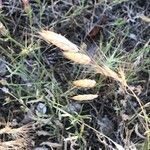Annual. Culms erect, 40–90 cm tall. Leaf sheaths pubescent; leaf blades 12–30 cm × 4–8 mm, both surfaces pubescent; ligule 1–2.5 mm. Panicle effuse, 20–30 × 5–10 cm, nodding; branches 2–8, 5–10 cm, slender, each bearing 1–4 spikelets. Spikelets lanceolate-oblong, 12–20 × ca. 5 mm, yellowish green, florets 7–11, closely overlapping; rachilla internodes shortly clavate, ca. 2 mm; glumes subequal, keel scabrid, margins membranous, lower glume 5–7 mm, 3–5-veined, upper glume 5–7.5 mm, 7–9-veined; lemmas elliptic, 8–10 × ca. 2 mm in side view, herbaceous, 9-veined, usually glabrous, margins membranous with conspicuous angle at maturity, scabrid, apex obtuse, minutely 2-toothed, awned from 1–2 mm below apex; awn 5–10 mm, longer on upper lemmas than lower lemmas, base slightly flattened, conspicuously recurved at maturity; palea shorter than lemma, ca. 1 mm wide, keels stiffly ciliate. Anthers ca. 1 mm. Caryopsis 7–8 mm. Fl. and fr. May–Jul. 2n = 14.
More
Much like no. 16 [Bromus commutatus Schrad.], and apparently passing into it, but the panicle avg a little larger, and with slender, flexuous, spreading to drooping branches; spikelets (13–) 15–30 mm; lemmas (6–)7.5–9 mm, 1.2–2.2 mm wide in side view; awns 7–12 mm, flexuous or recurved-divergent, the longest ones of a spikelet more than twice as long as that of the lowest lemma; palea 1–2.5 mm shorter than the lemma; 2n=14. Native of the Old World, intr. as a weed in waste places from N.H. and Vt. to Ga., w. to the Pacific.
An annual grass. It grows 50-90 cm high. The leaf blades are 20 cm long by 2-5 mm wide. The flowers are green. The flower panicle is 6-20 cm long and open and spreading.

